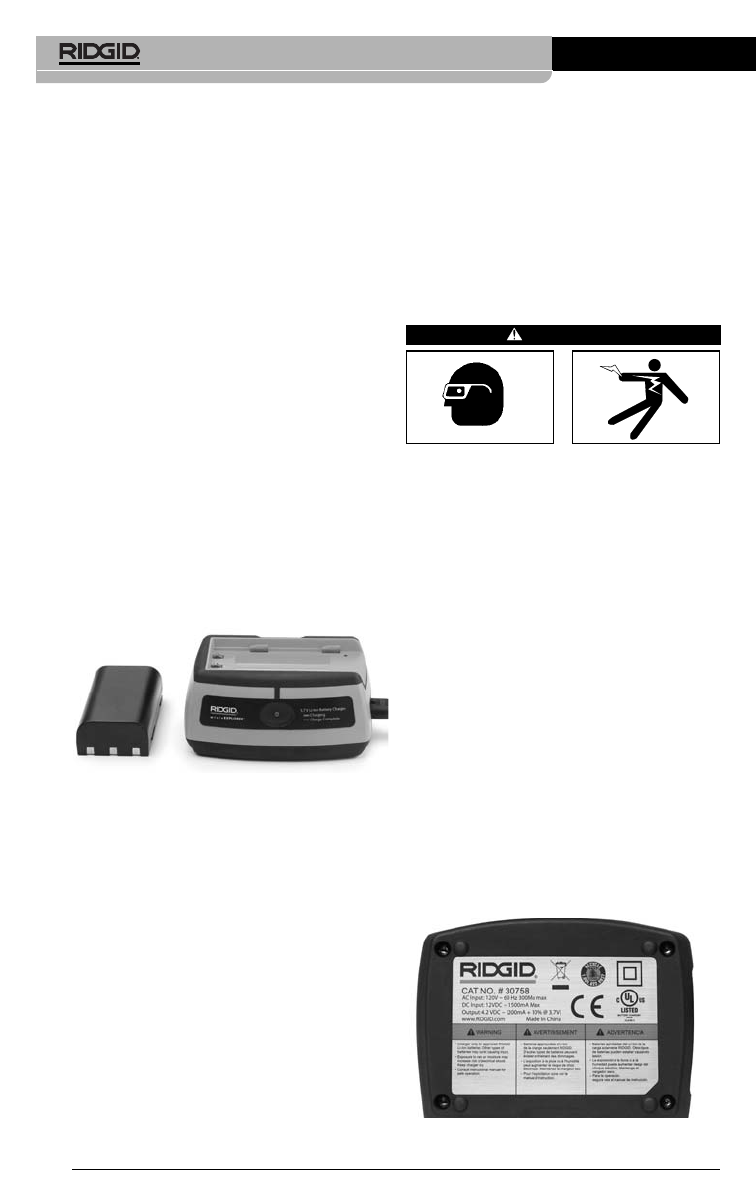
microEXPLORER
™
DigitalInspection Camera
Ridge Tool Company
18
• Do not insert the battery with cracked
case into charger. Damaged batteries
increase the risk of electrical shock.
• Never disassemble battery. There are
no user-serviceable parts inside the battery
pack. Disassembling batteries may cause
electrical shock or personal injury.
• Avoid contact with fluids oozing from
defective battery. Fluids may cause burns
or skin irritation. Thoroughly rinse with
water in case of accidental contact with
fluid. Consult doctor if fluid comes into
contact with eyes.
Description,
Specifications and
Standard Equipment
Description
The RIDGID Battery Charger (Catalog Num-
ber 30758), when used with appropriate bat-
tery packs (Catalog Number 30198) listed in
the Accessories section, is designed to charge
a 3.7V Lithium Ion RIDGID battery in approx-
imately 4-5 hours. This charger requires no ad-
justments.
Figure 31 – Battery and Charger
Battery & Charger
Specifications
Input............................100-240 VAC/
12 VDC 50/60Hz
Output.........................4.2V DC
Battery Type ...............3.7V Lithium Ion
Input Current
.................0.3A/1A(DC)
Weight ........................0.4 lbs (0.02 kg)
Dimensions:
Length .......................4.1" (10.4 cm)
Width.........................3.3" (8.4 cm)
Height........................1.8" (4.6 cm)
Charge Time...............4-5 hours
Cooling.......................Passive Convention
Cooling (No Fan)
NOTE! This charger and batteries are not com-
patible with any of RIDGID Li-Ion Bat-
teries and chargers. See
Accessories
section for batteries compatible with
this charger.
Charger Inspection and
Set-Up
WARNING
Daily, before use, inspect the charger
and batteries and correct any problems.
Set up charger according to these proce-
dures to reduce the risk of injury from
electrical shock, fire, and other causes
and prevent tool and system damage.
1. Make sure the charger is unplugged.
Inspect the power cord, charger and bat-
tery for damage or modifications, or bro-
ken, worn, missing, misaligned or binding
parts. If any problems are found, do not
use charger until the parts have been
repaired or replaced.
2. Clean any oil, grease or dirt from the
equipment as described in the
Mainten-
ance
section, especially handles and
controls. This helps prevent the equip-
ment from slipping from your grip and
allows proper ventilation.
3. Check to see that all warning labels and
decals on the charger and battery are
intact and readable. The figures below
show the warning labels on the bottom of
the charger and the bottom of a battery.
Figure 32 – Label on Charger


















